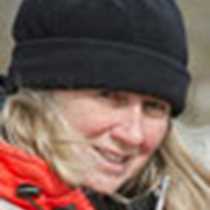Península Valdés, Argentina
The land seems vast, endless, even empty as we travel through this sea of shrubs and grass. Few cars pass our caravan of coaches although we drive down a major highway here at the edge of Patagonia. At the dock in Puerto Madryn where southern right whales dance between bright red fishing boats, our own blue-hulled lady awaits our return. She too seems to interest the cow/calf pairs and they entertain the few who stayed aboard having selected a morning at ease.
A human might feel lonely here between the settled sites and certain points of interest where visitors stop to congregate. But it takes only a few moments scanning the rolling hills or the edges of the sea to discover life abounds and surrounds us here. Turkey vultures soar, riding the thermals high, their wings in a perfect diahedral pose. Lesser rheas zig and zag between the thorny shrubs and yellow flowered creosote. Patagonian hares, rodents mimicking rabbits or kangaroos, bounce down gravel tracks while graceful guanacos gaze at us with apparent curiosity before going back to grazing with unrelated merino sheep.
To look at a map the Península Valdés seems to be exfoliating a slice of itself like an onion skin. In reality the Caleta is a massive gravel deposit striped from bay to sea with a myriad of tracks of sorts. At its tip a pattern of green and black was revealed by the sinking tide, and it was here in the remaining pools the source of the trails were found. Elephant seals, their blubbery bodies squirming along went from sea to shore or just lounged lethargically cooling uncomfortable moulting pelts on wet refreshing stones. Two teenaged pinnepeds reared up in mock battle practicing for the day that one or both would become beach master sporting an elephantine snout. Just offshore, patient killer whales milled waiting for an unweary "weaner," a pup recently rejected by its mom to make an error in judgment and swim too close to the edge.
Puerto Pirámides nestles at the western edge of the diverticulum-like peninsula, tucked neatly into the bay of Golf Nuevo. It might appear to be a sleepy town, but that too is an illusion. Launched by tractors pushing trailers, whale watching boats come and go. Two bore us through the surf to see a frolicking cow/calf pair that rolled and waved with paddle-like pectoral flippers and elegant flukes. Occasionally the calf displayed more exuberance and tried to fly only to return to the water with a crashing splash. On a stage-like rocky platform three species of cormorants stood. The sea washed onto the terrace and pooled as if made of mercury, reflecting the courtship bows of a heavy maned South American sea lion and his dainty chosen mate.
We could go on and on, but by now, the point has been made. Patagonia is vast and wild and filled with fascinating life.
The land seems vast, endless, even empty as we travel through this sea of shrubs and grass. Few cars pass our caravan of coaches although we drive down a major highway here at the edge of Patagonia. At the dock in Puerto Madryn where southern right whales dance between bright red fishing boats, our own blue-hulled lady awaits our return. She too seems to interest the cow/calf pairs and they entertain the few who stayed aboard having selected a morning at ease.
A human might feel lonely here between the settled sites and certain points of interest where visitors stop to congregate. But it takes only a few moments scanning the rolling hills or the edges of the sea to discover life abounds and surrounds us here. Turkey vultures soar, riding the thermals high, their wings in a perfect diahedral pose. Lesser rheas zig and zag between the thorny shrubs and yellow flowered creosote. Patagonian hares, rodents mimicking rabbits or kangaroos, bounce down gravel tracks while graceful guanacos gaze at us with apparent curiosity before going back to grazing with unrelated merino sheep.
To look at a map the Península Valdés seems to be exfoliating a slice of itself like an onion skin. In reality the Caleta is a massive gravel deposit striped from bay to sea with a myriad of tracks of sorts. At its tip a pattern of green and black was revealed by the sinking tide, and it was here in the remaining pools the source of the trails were found. Elephant seals, their blubbery bodies squirming along went from sea to shore or just lounged lethargically cooling uncomfortable moulting pelts on wet refreshing stones. Two teenaged pinnepeds reared up in mock battle practicing for the day that one or both would become beach master sporting an elephantine snout. Just offshore, patient killer whales milled waiting for an unweary "weaner," a pup recently rejected by its mom to make an error in judgment and swim too close to the edge.
Puerto Pirámides nestles at the western edge of the diverticulum-like peninsula, tucked neatly into the bay of Golf Nuevo. It might appear to be a sleepy town, but that too is an illusion. Launched by tractors pushing trailers, whale watching boats come and go. Two bore us through the surf to see a frolicking cow/calf pair that rolled and waved with paddle-like pectoral flippers and elegant flukes. Occasionally the calf displayed more exuberance and tried to fly only to return to the water with a crashing splash. On a stage-like rocky platform three species of cormorants stood. The sea washed onto the terrace and pooled as if made of mercury, reflecting the courtship bows of a heavy maned South American sea lion and his dainty chosen mate.
We could go on and on, but by now, the point has been made. Patagonia is vast and wild and filled with fascinating life.




